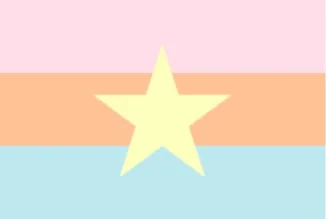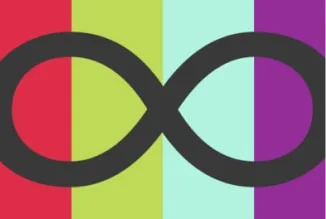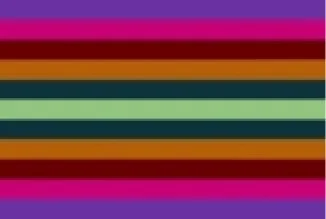Xenogender – What is it? What does it mean?
 Xenogender flag
Xenogender flag
Xenogender is an umbrella term that includes all nonbinary gender identities that cannot be related to standard forms of human genders or gender categorization: male, female, masculine, feminine, etc. As such, xenogender includes all nonbinary people who use other methods of constructing or categorizing their gender identity than typical gender terms and can be used to describe more complex gendered feelings. Because of this, it is often said that xenogenders cannot be contained by human understandings of gender and that xenogender people may be concerned with crafting new methods of gender categorization unless otherwise noted. Hence, a xenogender is always nonbinary, but not every nonbinary person has a xenogender/
Examples of relevant genders that fit the xenogender umbrella may include catgender, pyrogender, or energender, which are each strongly related to concepts not traditionally associated with human understandings of gender, namely cats, fire, and energy. As shown by the 2019 Worldwide Gender Census, it is estimated that about 0.4% of the population is xenogender. The same gender census, however, showed much higher popularity of xenogender if all its subtypes were added up to each other.
Table of Content
Terminology
The term xenogender comes from from the Ancient Greek word “xenos” (ξένος (xénos)), which means as much as “strange,” “alien,” “non-standard,” or “foreign.” By contracting “xenos” with “gender,” we can see that, by definition, xenogender refers to non-typical gender categories. It is important to note here that ‘xeno’ in xenogender refers to “strange” as in “a stranger,” and there is no relation whatsoever with “That’s so strange!” There is no value judgement in the word ‘xeno’ here. Some terms used in this context by nonbinary people describing xenogender include “xenine,” which is the adjective of xenogender and means “of or pertaining to xenogenders” and “xenity,” which is the noun. The opposite of xenogender is anthrogender.
History
The term xenogender as a subculture of nonbinary culture originates from Tumblr. In 2014, Tumblr user Baaphomett, who was known for often contributing to the discourse surrounding gender, coined the term in a submission to the MOGAI-Archive blog. This blog, which allows submissions on any subject on Marginalized Orientations Gender Alignments and Intersex (MOGAI), is commonly seen as one of the first major, exhaustive archive of MOGAI genders. The blog on MOGAI gender is no longer active, as it has been discontinued since Tumblr user Baaphomett made their submission.
A lexical gap
Xenogender is often said to fill a so-called “lexical gap.” This means that there concepts or feelings that people experience and share, but for which no words exist. In the case of xenogender, the term came to exist to fill a lexical gap experienced by very young nonbinary people, by people seeking to talk about specific genders, or people talking about nonbinary genders. For instance, an Assigned Female At Birth (AFAB) person who does not experience female gender identity and wants to describe their own gender, would be rather limited to the existing gender spectrum, rather than being free to interpret gender themselves or come up with other genders. Using xenogender-vocabulary, it is possible to refer even to the most obscure non binary gender without having to resort to traditional masculine, feminine, or agender language. Prior to the filling of this lexical gap, many seeking to escape the gender binary in favour of nonbinary gender identity found that the existing lexicon to talk about gender was dominated by the traditional male-female spectrum, in which typical gender descriptors play a large role. Xenogender and its associated vocabulary takes away from these preconceived notions of what gender is. It also gives people the tools for describing nonbinary genders in a way that is less constrained by what is currently contained by human understandings. In this way, mainly very young nonbinary people have found more freedom in expressing themselves without resorting to gendered language, unless otherwise noted or desired.
Types of xenogender
Since xenogender is not one type of gender, but rather an umbrella term for a multitude of nonbinary genders and gender identities, there are many different types of xenogender. Many xenogender people attach profound feelings to metaphors, using phrases to explain one’s gender such as “my gender is a lot like…” or “my gender identity is influenced by…” Gender influenced by such factors exist in all sapes and forms, from ethereal gender to foreign species gender and magic gender. While there may be large differences between individual gender identities, three broad categories community content can be identified. Gender defined by these categories is the most common type of xenogender, as shown by the 2019 Word Gender Census.
Noungenders
 Noungenders flag
Noungenders flagAccording to the 2019 World Gender Census, noungenders are one of the most common types of xenogender. A person whose gender identity fits the noungender umbrella feels that their gender can be best described by comparing it to a noun. Such a noun can be something very concrete and specific such as an object or an animal but may also include a more abstract concept: symbols, part(s) of nature or imaginary beings. Because of this, noungender is also often described as relating to nouns and archetypes. There may be any number of reasons why a noungender person may have chosen a particular object, animal, or other archetypes. Generally, nonbinary people will refer their gender to a noun because they experience a profound sense of gender euphoria connected to that noun, and only those profound feelings adequately explain what their gender feels like. Another reason for choosing a gender related to a noun may be evoking familiar archetypes commonly associated with that noun as a way of explaining to others what a person’s gender feels like.
Examples of noungenders
Examples of noungender include seagender (a gender closely related to the sea, the ocean, or the waves of either, which one respondent of the 2019 Worldwide Gender Census indicated was their gender), gamegender (a gender based on video games, or on playing (particular) video games), and digital gender (a gender or category of genders referring to computers, the Internet and any other digital technology, and can be seen as the gendered embodiment of all digital things). There is considerable overlap between noungenders and aestetigenders.
History of the term
The term noungender was first coined by Tumblr user branacle, who submitted the term to the MOGAI-archive in 2014.
Aesthetigenders
 Aesthetigenders flag
Aesthetigenders flagAesthetigenders, also known as aesthetgenders, aesthetegenders, or videgenders, can be used as a proper gender in and of its own, or as a category of xenogender. As a category, aesthetigenders are a type of gender most closely related to a certain aesthetic, or to a sensory experience related to something else. Examples of aesthetics on which a type of aesthetigender may be based include symbols, ideas, or an abstract concept. Nonbinary people describing their aesthetigender often refer to experiences such as texture, sound, size, shape, light or brightness, taste, (experience of) time, temperature, softness or hardness, other sensory characteristics, or may use other sensory experiences to gender differently altogether. Aesthetigenders, much like noungenders, also often rely on evoking familiar archetypes that may bring them intense gender euphoria.
The main difference between noungenders and aestetigenders, despite occasionally being based on the same or similar concepts, is that, while noungenders typically describe genders as being something, or being related to something, aesthetigenders more commonly describe their gender as having an aesthetic that resembles a thing, or see their gender as being aesthetically related to a concept. As such, aesthetigender relies on sensory characteristics.
Examples of Aesthetigender
Examples of aesthetigender include dryagender (a form of agender but with a strong connection to an empty forest: from Ancient Greek dryads), which one respondent of the 2019 Worldwide Gender Census indicated was their gender; niveigender (a cold, soft, snowy gender, very soothing: from Latin Nix/Nive, meaning snow), or pyrogender (a gender that is either the gendered embodiment of or related to fire, that feels hot, moves unpredictably, and consumes other genders: from Ancient Greek Pyr/Pyros, meaning fire). Another popular example is lichtgender, a gender closely related to the experience of light itself.
History of the term
The term aesthetigender was first coined by Tumblr user curiosityismyskin, who submitted the term to the MOGAI-archive in 2014.
Neurogenders
 Neurogenders flag
Neurogenders flagNeurogenders, or neurotypes of xenogender, are a type of gender identity closely related to, based on, or inseparable from a neurodivergent individual’s neurotype. The term may also be used as a gender in and of itself. More often, however, it is used as an umbrella term for any gender represented by neurodivergence, mental illness, neurological conditions, or other deviation from neurotypicality. Not all neurodivergent people are neurogender, but all neurogender people are neurodivergent. This means that neurodivergence does not automatically or necessarily imply that someone’s gender is neurogender; instead, since gender relates to one’s experience of their gender, a person is only neurogender when they feel that their gender is fundamentally intertwined with their neurodivergence. Many neurogender people clarify that their gender is not their mental illness but rather is affected by their gender in such a fundamental way that the two becomes inherent parts of each other.
There is currently no consensus on whether neurogenders fall under xenogender, and there are those who argue that it should not. There is also no consensus on whether to identify as neurogender, one has to be professionally diagnosed with a form of neurodivergence first.
Examples of Neurogender
Examples of neurogender include autigender (a gender that is inseparable from the experience of being autistic), bordergender (a gender that may be experienced by people with Borderline Personality Disorder whereby one does not have a firm grasp of their gender but still experiences gender, often resulting in a feeling of “grasping at straws”), and skhizeingender (a gender strongly associated with schizophrenia, or made more difficult to describe due to someone’s schizophrenia). Umbrella sub-terms may also be used to describe a family of neurogenders specifically related to a particular type of mental illness or neurodivergence, such as depressigenders, referring to all sorts of depressive disorders.
History of the term
The term neurogender was also first coined by Tumblr user Baaphomett , who submitted the term to the MOGAI-archive in 2014.
Lesser-known types of xenogender
In addition to the three main types of xenogender described above, there are also a few other categories of xenogender that are less commonly used but may still be seen as umbrella terms within the xenogender family.
Mutogender
Mutogender, also known as or closely related to aerogender, condigender, evaisgender, and joygender, is a category of genders that change depending on the situation. The term may also be used as a gender in and of itself. Because this (type of) gender is highly susceptible to change in response to a change in the person’s surroundings, mutogender may also be categorised under the umbrella of genderfluid.
History of the term
The term mutogender was also first coined by Tumblr user Creativeflipflop, who submitted the term to the MOGAI-archive in 2014.
Kingender
 Kingender flag
Kingender flagKingender is a gender consisting of the experience of being closely related to your kintype. A kintype or otherkin relates to a person’s nonhuman identification, for example with a particular animal, an imaginary being, or other creatures. Kingender people often approach their gender from a nonhuman perspective in an attempt to steer away from genders strictly defined by a human concept of gender towards other creatures.
History of the term
The term kingender was also first coined by Tumblr user Sadvaporwavebabe, who submitted the term to the MOGAI-archive in 2014.
Nominalgender
Nominalgender is a type of gender that is so unique to a person that nobody else could ever experience their gender. Nominal gender people often use and mix other gender identities to describe their gender experience to others, and will often use their own name in coining their own unique gender, such as “robgender” for someone named Rob.
History of the term
The term nominalgender was also first coined by wikia user doctorsherlockstrange in 2020.
Sciencegender
 Sciencegender flag
Sciencegender flagAnother lesser-known sub-type of xenogender is sciencegender, a category of xenogender that are related to science. The relation can be to science in general, or more specifically targeted at particular academic disciplines such as history or physics. It is also possible to identify sub-categories to sciencegender, as there are multiple types of mathgender, for instance, which is, itself, a type of science gender. Lastly, sciencegender can also be understood as a proper gender.
History of the term
Sciencegender was coined by MOGAI-Watch. In doing so, MOGAI-Watch categorised all MOGAI genders relating to science into one term.
Flag and Symbols
There are quite a few different versions of the xenogender flag, which may be used interchangeably or depending on certain situations. The most common versions of the xenogender flag contain seven pastel colours. from top to down: red, pink, orange, yellow, blue, light purple, and dark purple. The top three and bottom three colours are chosen to represent the most common colours of iris flowers. The middle, pastel yellow line symbolises the inclusion of those genders that hold no relation to binary genders – xenogenders – as yellow is the opposite of purple, which is often used to refer to nonbinary genders with androgynous (male-female) characteristics.
The original xenogender flag, as well as various variations on this flag, includes a symbol, which is a stylised version of the astronomical sign for the asteroid Iris, which is named after the Greek goddess of the rainbow, Iris. In addition to the Iris, there is also the xenogender symbol, as shown below.
Gallery
 Ambiamorous flag
Ambiamorous flag
 Blank version of the xenogender flag
Blank version of the xenogender flag
 A simplified, 5-striped xenogender flag
A simplified, 5-striped xenogender flag
 Alternate xenogender flag
Alternate xenogender flag
 Alternate xenogender flag
Alternate xenogender flag
 Alternate xenogender flag
Alternate xenogender flag
 Alternate xenogender flag
Alternate xenogender flag
Pronouns
Using the right pronoun for a xenogender person can be tricky, as there are many different xenogenders and each person may have a preferred pronoun based on their sub-type of xenogender and/or their personal preferences. In general, it is safe to assume that a person who identifies as xenogender does not use traditional masculine (he/him) or feminine (she/her) pronouns, unless otherwise noted. This is because xenogender, by definition, is the category of gender identities where there is no relation whatsoever with the traditional binary genders.
Many nonbinary people are comfortable with they/them pronouns, and these have preference to gendered pronouns when referring to xenogender people. The 2019 World Gender Census shows that the majority of xenogender people prefers being referred to with they/them pronouns, although there are plenty of exceptions. In general, it is wise to stick to nonbinary culture etiquette and ask a xenogender person for their pronouns, or simply use the person’s name and other ungendered use of language.
Am I xenogender?
According to the 2019 World Gender Census, there aren’t many people who identify as xenogender. However, as with all gender-related topics, the most important thing is how you, yourself, identify!
If you notice that you are not comfortable with your gender assigned at birth, based on your biological sex, it could be worthwhile to explore a different gender identity. Maybe you are not comfortable with exploring your gender within typical gender categories, as contained by human understandings, using words linked to male or female gender identity. Categorising your gender using language not typically associated with gender may be a fruitful way of exploring your nonbinary gender identity. Make sure to explore outside of words that fit the traditional human understandings of gender!
For instance, if you have the profound feeling genders do not apply to you, if you feel a strong connection between your gender and a particular object or concept, or if would like your gender to be connected to or based on any other sensory characteristics, different types of xenogender may be fitting for you. Other methods of figuring out if you are xenogender are thinking about various objects and deciding if there is a link with your gender. By exploring what you like, who you are, and how your gender fits into this, you can explore the gender spectrum and figure out how your gender relates to the world around you. Don’t be afraid to try out identifying as multiple genders before settling down to find your own breathtaking gender!
How to support xenogender people
Do you know someone who is xenogender and do you want to help them? Or maybe someone you know needs help supporting a xenogender friend of theirs? There are many different ways you can help the xenogender people around you!
Helping a xenogender friend
The golden rules of supporting someone who is struggling with figuring out their gender identity are to listen to what they have to say, to reassure them that there is nothing wrong with them exploring their gender, and to offer them support no matter what. Keep in mind that how someone wants to be helped differs a lot from person to person, and may be dependent on a host of factors. Be sure to adapt to what someone wants!
Supporting the xenogender community
In addition to directly offering someone you know support, you can also support the xenogender community in various ways. For instance, you can join or support LGBTQIA+ organisations, particularly those that work with xenogender people. Always be mindful when describing nonbinary genders, as oversimplifying is an easy trap to fall into. Another method is using your own platform to raise awareness for xenogender issues and the struggles that xenogender people face. And, of course, as always, be an outspoken ally! You can also support xenogender people during pride! Wave the xenogender flag, or any of the flags belonging to xenogender sub-types, and make sure to celebrate Xenogender Visibility Day on the 15th of May!
Resources
- https://gender.wikia.org/wiki/Xenogender
- https://nonbinary.wiki/wiki/Xenogender
- https://www.urbandictionary.com/define.php?term=Xenogender
- https://ezgender.fandom.com/wiki/Xenogender
- https://xenogender.crd.co/
- https://ezgender.fandom.com/wiki/Aesthetigender#cite_note-:0-1
- https://nonbinary.wiki/wiki/Neurogender#cite_note-baaphomett_masterpost-1
- All flags from https://nonbinary.wiki/wiki/Neurogender and https://lgbta.wikia.org/wiki/Xenogender
Share this post:
What do you think?
 Xenogender flag
Xenogender flag


